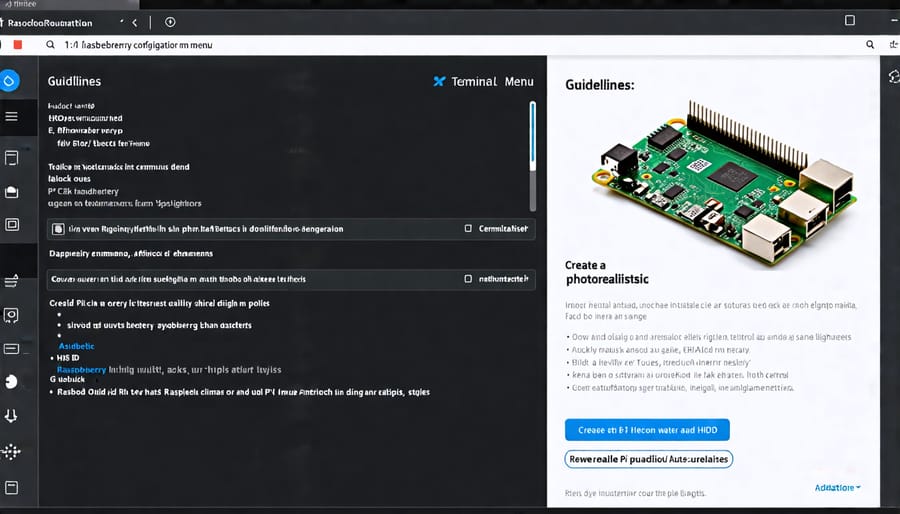Configure your Raspberry Pi effortlessly through the command line with these essential steps: 1. Enter sudo raspi-config to access the Raspberry Pi configuration tool and modify system settings like timezone, locale, keyboard layout, and interfaces. 2. Use sudo apt update and sudo apt upgrade to keep your Pi’s software up-to-date and secure. 3. Set up Wi-Fi with sudo nano /etc/wpa_supplicant/wpa_supplicant.conf, adding your network details, then reboot. 4. Expand your filesystem to utilize the full SD card capacity via sudo raspi-config > Advanced Options > Expand Filesystem. Master your Pi’s core functionality and unlock its full potential through these critical command line configurations.

Getting Started with the Terminal
Opening the Terminal
To open the terminal on your Raspberry Pi, start by booting up the device and navigating to the desktop. Look for the terminal icon, which resembles a black screen with a command prompt, either on the desktop or in the application menu. Click on the terminal icon to launch the command line interface. Alternatively, you can open the terminal using a keyboard shortcut. Press the “Ctrl + Alt + T” keys simultaneously, and the terminal window will appear on your screen. Once the terminal is open, you’ll see a command prompt where you can start entering commands to configure your Raspberry Pi. The prompt typically includes your username, the device’s hostname, and the current directory.
Essential Navigation Commands
To navigate the Raspberry Pi’s file system via the command line, you’ll need to know a few essential commands. Use “ls” to list the contents of the current directory, revealing files and subdirectories. Change to a different directory with the “cd” command followed by the directory path. For example, “cd /home/pi” moves you to the Pi user’s home directory. If you ever get lost, the “pwd” command prints the current working directory, showing your exact location in the file system. These basic commands enable efficient terminal-based navigation on your Raspberry Pi.
10 Must-Know Commands for Raspberry Pi Configuration
sudo raspi-config
The `sudo raspi-config` command is a powerful tool for accessing the Raspberry Pi configuration menu directly from the command line. By running this command, you can easily modify various system settings without the need for a graphical user interface. The `raspi-config` menu provides a user-friendly interface for tasks such as changing the default password, setting the time zone, enabling camera and SSH interfaces, and configuring memory splits for optimal performance. This command is particularly useful when working with a headless setup or remotely accessing your Raspberry Pi via SSH. To use it, simply open the terminal and type `sudo raspi-config`, then navigate through the menu options using your arrow keys and Enter to select. Remember to reboot your Raspberry Pi after making any significant changes to ensure they take effect. Mastering the `sudo raspi-config` command will give you greater control over your Raspberry Pi’s configuration and streamline your project setup process.

Changing the Default Password
To change the default ‘raspberry’ password, open a terminal and type ‘sudo passwd pi’. You will be prompted to enter a new password. Choose a strong, unique password and enter it twice to confirm. This critical step changing the default password significantly enhances your Raspberry Pi’s security. Be sure to remember your new password, as you will need it for future logins and administrative tasks. By taking a few moments to update your password, you are protecting your device from unauthorized access and potential security breaches.
Configuring Network Settings
To configure network settings via the command line, start by using sudo raspi-config to access the configuration menu. Navigate to “System Options” and then “Wireless LAN” to set up Wi-Fi. Enter your network’s SSID and password when prompted. For a static IP, edit the /etc/dhcpcd.conf file with sudo nano /etc/dhcpcd.conf. Uncomment the interface eth0 or interface wlan0 line (depending on whether you’re using Ethernet or Wi-Fi) and add the following lines:
static ip_address=192.168.1.100/24
static routers=192.168.1.1
static domain_name_servers=192.168.1.1 8.8.8.8
Replace the IP addresses with your desired static IP, router IP, and DNS servers. Save the file and reboot with sudo reboot for the changes to take effect. To scan for available Wi-Fi networks, use sudo iwlist wlan0 scan. This command provides detailed information about nearby networks, including their SSIDs, signal strengths, and security settings.
Enabling SSH and VNC
To enable SSH and VNC on your Raspberry Pi using the command line, start by opening the terminal. Run the command `sudo raspi-config` to access the configuration tool. Navigate to the “Interface Options” menu and select “SSH” or “VNC” to enable these remote access protocols. Follow the prompts to confirm your choice. Once enabled, you can remotely connect to your Raspberry Pi using an SSH client or VNC viewer from another device on the same network. This allows you to control your Raspberry Pi without needing a directly connected keyboard, mouse, or monitor.
Updating the Raspberry Pi
Keeping your Raspberry Pi up-to-date is crucial for security, stability, and accessing the latest features. The apt package manager simplifies this process via the command line. To update your Pi’s software, run “sudo apt update” to refresh the package lists, followed by “sudo apt upgrade” to install available updates. It’s good practice to perform these steps regularly. For a more comprehensive upgrade, use “sudo apt full-upgrade”. This command handles dependencies and can remove packages if needed. Updating the Raspberry Pi‘s firmware is also important. The “sudo rpi-update” command takes care of this, but use it with caution as it updates to the latest bleeding-edge firmware.
Overclocking the Raspberry Pi
To safely overclock your Raspberry Pi using config commands, start by opening the config.txt file with the command sudo nano /boot/config.txt. Look for the “#overclock” section and uncomment the relevant lines. Set “arm_freq” to your desired CPU frequency (e.g., 1500 for 1.5GHz) and “over_voltage” to the corresponding voltage (e.g., 6 for 1.5GHz). Increment these values gradually and test stability after each change. You can also overclock the GPU by setting “gpu_freq” (e.g., 500 for 500MHz). Additionally, ensure adequate cooling, as overclocking generates more heat. To monitor temperatures, use the command vcgencmd measure_temp. If temperatures exceed 80°C or you experience instability, dial back the overclock. Always backup your SD card before overclocking and be prepared to troubleshoot if issues arise. With careful tweaking, you can boost your Pi’s performance for demanding projects.

Scheduling Tasks with Crontab
The Raspberry Pi’s crontab utility allows you to automate scripts and tasks on a schedule. To edit the crontab file, run crontab -e in the terminal. Each line represents a task, specified in the format: * * * * * command. The asterisks represent minute, hour, day of month, month, and day of week, respectively. For example, 0 9 * * * python myscript.py runs the Python script every day at 9 AM. Save the file and exit to activate your scheduled tasks. Crontab simplifies automating backups, updates, and custom scripts on your Raspberry Pi.
Customizing the Bash Prompt
To customize your Bash prompt, edit the `.bashrc` file in your home directory. Open it with `nano ~/.bashrc` and locate the `PS1` variable. This string defines your prompt’s appearance. Use special characters like `\u` for username, `\h` for hostname, and `\w` for current directory. For example, `PS1=’\u@\h:\w$ ‘` displays “username@hostname:directory$”. You can also add color codes, like `\[\033[01;32m\]` for green text. After saving changes, run `source ~/.bashrc` to apply them. Experiment with different configurations to create a personalized prompt that suits your style and enhances your command line experience on the Raspberry Pi.


